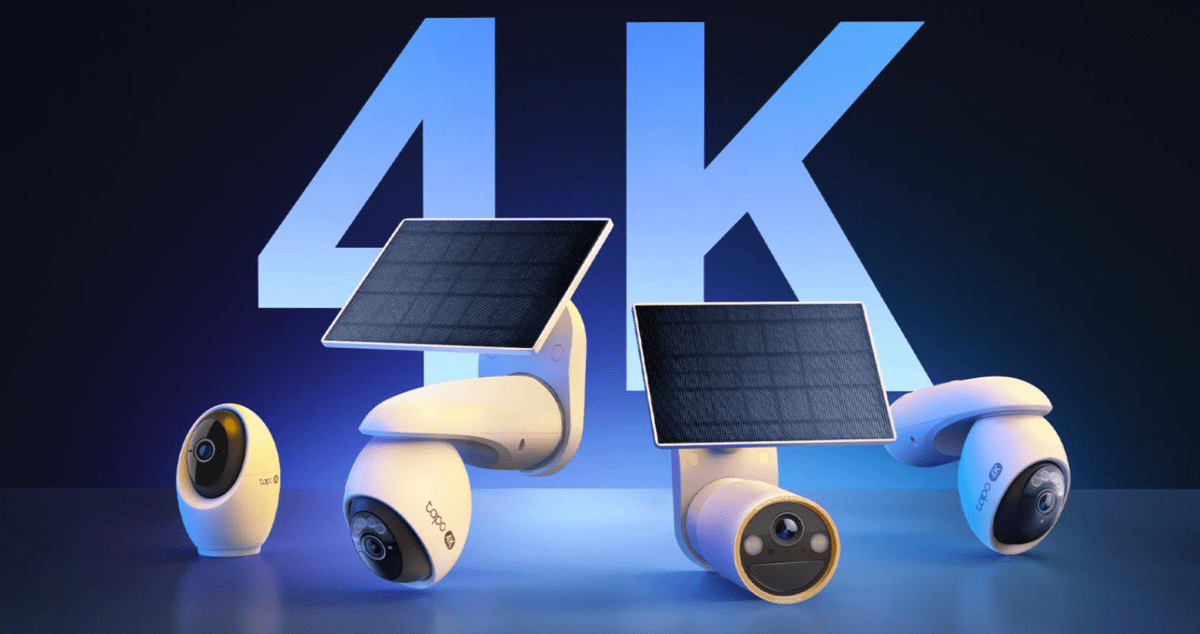TP-Link just launched a bunch of new security cameras for its Tapo smart home brand, including a 4K-capable line for outdoors and a slew of inexpensive pan and tilt cams that can be used indoors and out — all without any subscription fees. The company is also finally releasing its Tapo HomeBase H500 hub, first shown at CES 2024, which brings facial recognition and expanded local storage to its cameras.
The HomeBase will also act as a Matter controller, allowing you to add non-Tapo smart home devices, such as lights and locks, to the Tapo app. However, cameras aren’t part of the Matter smart home standard, so, for now, the Tapo cameras will only work with Amazon Alexa, SmartThings, and Google Home over Wi-Fi.
The new releases, which are available now at Amazon and TP-Link’s site, feature an upgrade to the battery-powered Tapo MagCam series, bringing 4K 8MP resolution footage and Starlight color night vision (which shows clearer images even in low light). There’s a standard camera, the $149.99 Tapo MagCam 4K Solar (C460), and a pan-tilt version, the $169.99 Tapo VistaCam 360 Solar (C660).
Both have solar power integrated into the mounting system and can record 24/7 on battery – something few other battery-powered cameras do. “We introduced a 24/7 Capture feature that allows the camera to take still images at customizable intervals, such as every 1 or 5 seconds, even when no motion is detected,” explained David Lux, marketing director at TP-Link. “This ensures round-the-clock monitoring while conserving battery life. When motion is detected, the camera automatically switches to standard video recording.”
According to TP-Link, the cameras can record up to 55 days on one charge using the adjustable frame rate to save power, and require as little as 45 minutes of sun a day on the solar panel to keep it fully powered.
A wired version of the VistaCam, Tapo C560WS, costs $99.99 and supports on-device facial recognition along with 24/7 recording at 25 FPS.
All of the new Tapo cameras have the option of local recording to a microSD card (sold separately) and to Tapo’s new HomeBase at no charge, or you can opt for cloud storage with Tapo Care. The cameras have free AI-powered smart alerts for pets, people, and vehicles, processed on the device. The pan-tilt versions support auto-tracking of pets, vehicles, and people.
Tapo also has a new 4K-capable plug-in, indoor pan-tilt camera, the $59.99 Tapo RoomCam360 (C260), which supports 24/7 recording to an SD card or the HomeBase. It offers 360-degree horizontal coverage, a physical privacy shutter, smart alerts for people, pets, and vehicles, and noise detection for a baby crying, glass breaking, cat meowing, and dog barking.
A lower-cost option, the new Tapo HybridCams series, is a line of 2K-capable plug-in cameras that start at $30. All feature weather proofing, pan-tilt capabilities, and a multi-mount design that lets you place the camera flat on a surface or mount it to a wall or ceiling.
The $69.99 Tapo HybridCam Duo (C246D) is the most interesting here. It features dual-lens 2K 3MP cameras, one a 360-degree pan-tilt with a 6mm telephoto lens and the other a fixed lens with a 125-degree field of view, so it can cover wide spaces while simultaneously zooming in on details. The Duo has synchronized smart tracking, so if the fixed lens spots something, the pan-tilt lens can adjust to follow it. A 4K, solar-powered version was announced at CES this year, but there’s no sign of a launch for that model yet.
The HybridCam series also includes three single-camera options with the same design, starting at $29.99 for 1080p resolution, $34.99 for 2K, and $49.99 for 3K resolution. These models are all pan-tilt with auto-tracking and free AI-powered detection for people and sounds. The two more expensive cameras add pet and vehicle detection.
Tapo’s new hub matters
As mentioned, the cameras all have the option of local storage on the device with a micro-SD card or on the new $149.99 Tapo HomeBase (H500). A triangular hub with a built-in tablet mount (tablet not included), the HomeBase adds 16GB of local storage for cameras, expandable with an external hard drive to 16TB.
Tapo says the HomeBase, which supports Ethernet and 5GHz Wi-Fi, can manage up to 16 Tapo cameras as well as support ONVIF-compatible cameras. When connected to the HomeBase, all Tapo cameras gain local facial recognition.
You can connect a tablet to the stand, keep it powered via a USB port, and use it as a camera viewing device, showing up to four live views at once. Alternatively, you can hook the HomeBase up to a TV via its HDMI port. With a built-in microphone and speaker, the HomeBase can act as an intercom for Tapo’s cameras and video doorbells.
The HomeBase is a hub for Tapo’s sub-gig sensors and supports Matter-over-Wi-Fi devices, allowing it to act as a Matter controller. This means it can connect and control both Tapo smart home devices and Matter-compatible devices from other brands. So you should be able to use Tapo’s rules and automations to automate all your compatible gadgets in the Tapo app.
However, Lux said the HomeBase will only support Matter devices in the categories that Tapo currently supports, which include lighting, sensors, switches, plugs, and door locks. It’s certified for Matter 1.1 and can connect smart bulbs and plugs. Tapo says it’s working on Matter 1.3, which would add support for sensors and door locks.
While the hub works with Tapo cameras, it doesn’t support cameras via Matter, because cameras aren’t part of Matter. Lux said the CSA, the organization behind Matter, is working on adding cameras, and that when it does, “We are looking to be the first to support Matter cameras.” When (or if) that happens, it should be possible to add the cameras to Apple Home along with the other major platforms that support Matter.
Update, July 15th: Added a quote from Tapo clarifying how its battery-powered cameras capture footage 24/7 and included details on which version of Matter the HomeBase will support.
Follow topics and authors from this story to see more like this in your personalized homepage feed and to receive email updates.
Jennifer Pattison Tuohy









![Are you going to keep YouTube TV? [Poll]](https://naeamsocial.sfo3.digitaloceanspaces.com/tribenewsglobal/2025/11/12092548/96708-are-you-going-to-keep-youtube-tv-poll-420x280.jpg)

